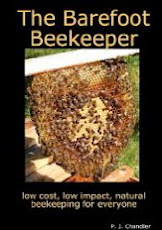
Honeybees are a joy to behold. Raising them and studying them is a great hobby. Beekeeping has been common for hundreds of years.
Just for the record book, here is a definition from Wikipedia:
"Honey bees (or honeybees) are a subset of bees in the genus Apis, primarily distinguished by the production and storage of honey and the construction of perennial, colonial nests out of wax."
Most of the honey making and gathering takes place during the spring and summer. This is when the hive is the most active. But what happens to our little friends during the cold weather?
The colony survives the winter inside the hive by population control. They do this by giving the guy honeybees the ole bee-boot, thus reducing the population. This works because there is no function for the males during cold weather. Their basic job is gathering nectar and pollen during warm weather. Sorry guys, ya gotta go! But don't worry, it is nature's way.
The remaining inhabitants in a man-made and maintained hive feed off the stored honey left in the hive by the beekeepers. Beginning beekeepers need to be aware that some honey should be left for just such a purpose.
During cold weather they cluster together to keep warm and rotate positions within the hive so that each takes his turn being on the colder outer area and the warmer inner area. To generate extra heat when needed, workers will consume honey and move in and out of the center all the while raising their body temperatures by contracting the flight muscles in the thorax without moving the wings.
Some folks who practice backyard beekeeping may provide some kind of shelter for their honeybees. This might be a cover that fits over the boxes or a physical shelter or lean-to to protect the boxes from wind and extreme temperature. Suggested temperature for winter maintenance is about 40 degrees.
Once the weather begins to change and spring approaches, activity inside the hive picks up. At this time, if a colony is too crowded they will swarm. This is when the old queen gathers about half of the inhabitants of the hive and heads out to find another place to carry out business.
You may see swarms during the spring on a protruding branch or even a city light pole as they wait for scouts to find a suitable place for the new colony.
This is the time when a backyard beekeeping gets interesting. The beekeeper needs to be aware that he can add additional boxes or hive space to keep his colony from swarming. Selling overstocked bees is a side benefit of the hobby.
Also, if you want to get started in the hobby, you may be able to locate starter swarms by contacting your local area beekeeping club.
New colonies now begin to build the wax core of the hive to store honey and build the population of the hive. There will be a "girl fight" between queens until only one remains. She will lay eggs to produce new workers and drones, and the honey production begins.
Backyard Beekeeping is a worthy hobby - one worth considering. It can pay for itself when you sell the honey. You can join local clubs of folks who share your interests and passions. These club members are always ready and willing to give you advice, especially if you are a beginning beekeeper. Find out more at http://www.squidoo.com/how-to-raise-honeybees. |













